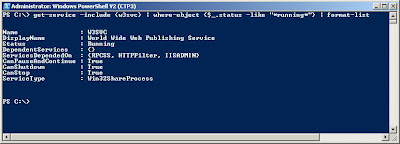Windows PowerShell is a command-line shell and scripting environment that brings the power of the .NET Framework to command-line users and script writers. It introduces a number of powerful new concepts that enables you to extend the knowledge you have gained and the scripts you have created within the Windows Command Prompt and Windows Script Host environments.

Figure 1.0 PowerShell window.
Windows PowerShell V2 Community Technology Preview 3 (CTP3)
- Download from here
- Getting Started
- Scripting with PowerShell
- Online help
- How to install/uninstall Powershell
- PowerShell Developer Guide
PowerShell Benefits
- Extension to command line windows.
- Performing common system administration tasks. E.g. managing the registry, services, processes, and event logs, and using Windows Management Instrumentation(WMI).
- Simplified, command-based navigation of the operating system, which lets users navigate the registry and other data stores
- Read WMI object values and invoke its method directly.
I hope the following list of examples could get you playing:
1. Get help on particular command: man
2. See a list of command available: get-command
3. Clear the screen: clear-host
4. Show info for Http Web Server service: get-service -include {w3svc} | where-object {$_.status -like "*running*"} | format-list (As in Figure 1.0 command)
5. Get the system date: get-date
6. Get the service DisplayName only: get-service w3svc | format-list -property DisplayName
7. List service : get-service | where-object {$_.name -like "[v-z]*"} | Sort -descending "Status"
8. Show .net component methods:
9. Get newest 5 system event log entry:
"httpd"| Get-Service -computername fireserver | Get-Member
11. Start a service remotely
(Get-WmiObject -Computername
e.g.
(Get-WmiObject -Computername fireserver Win32_Service -Filter "DisplayName='Computer Browser'").InvokeMethod("StopService",$null)
12.
Copy-Item c:\mydoc\text.doc c:\backup
13. Create file/folder
New-Item c:\scripts\Windows PowerShell -type directory
14. Check file exist
Test-Path c:\scripts\
15. Write data into xml file
Get-Process | Export-Clixml c:\scripts\process-list.xml
16. Run a program. Use Invoke-Expression
Invoke-Item notepad.
17. How to see all previous commands and batch it up?
Get-History
or
h // alias for Get-History
Running it in batch
Invoke-History 34;Invoke-History 23
18. Filter command result by its property name
Get-Process -ProcessName svch* // list process with name starts with svch
Get-Process -ProcessName s?c* // list process with name starts with s followed by any character; followed by c and etc.
19. List environment variables
$env:computername
$env:classpath
More to come ....
Acronyms:
* cmdlet, wmi.
No comments:
Post a Comment